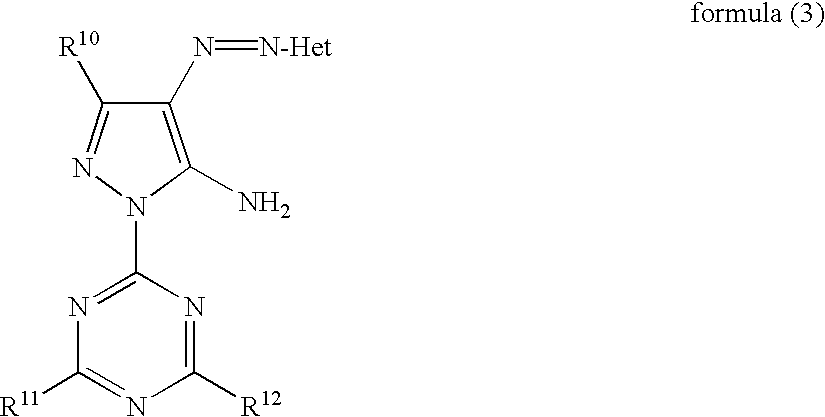Ink, ink jet recording method and azo compound
a recording method and technology of azo compound, applied in the field of azo dye, can solve the problems of reduced transparency and a change in the hue of transmitted color, difficulty in providing a dye that satisfies these requirements, and reduced light resistan
- Summary
- Abstract
- Description
- Claims
- Application Information
AI Technical Summary
Benefits of technology
Problems solved by technology
Method used
Image
Examples
synthetic example 1
10 g of cyanuric chloride was dissolved in 150 ml of acetone, and was added thereto 160 ml of an aqueous solution containing 13.6 g of taurine and 11.5 g of sodium carbonate at 15° C. or less under cooling with ice, and the resulting mixture was stirred at room temperature for 8 hours. 200 ml of acetone was added thereto, and the precipitated crystals were separated by filtration, to obtain 22 g of (a).
8.1 g of (a) was dissolved in 25 ml of water, 2 g of hydrazine was added thereto, and the resulting solution was heated at 70° C. for 2 hours and then concentrated. The precipitated crystals were separated by filtration, to obtain 5.7 g of (b).
A solution of 5.7 g of (b), 1.8 g of pivaloylacetonitrile, 3.6 g of sodium hydrogencarbonate, 30 ml of water and 30 ml of ethanol was heated for 2 hours, and after adding 8 ml of hydrochloric acid thereto, the resulting mixture was further heated for 2 hours. After concentration, the precipitated crystals were separated by filtration, to obtain ...
synthetic example 2
10 g of cyanuric chloride was dissolved in 150 ml of acetone, and was added thereto 160 ml of an aqueous solution containing 6.8 g of taurine and 6 g of sodium carbonate at 25° C. or less under cooling with ice, and the resulting mixture was stirred at room temperature for 8 hours and then concentrated, to obtain (a1). 20 g of hydrazine was added thereto at room temperature, and the resulting mixture was stirred at 70° C. for 3 hours. After concentration, methanol was added thereto, and the precipitated crystals were separated by filtration, to obtain 11.3 g of (b1).
A solution of 11 g of (b1), 9.6 g of pivaloylacetonitrile, 19.2 g of sodium hydrogencarbonate, 60 ml of water and 60 ml of ethanol was heated for 2 hours, and after adding 22 ml of hydrochloric acid thereto, the resulting mixture was further heated for 2 hours. After concentration, the precipitated crystals were separated by filtration, to obtain 9.3 g of (c1).
A mixed solution of 1.2 g of (c1), 7 ml of methanol, 4.8 ml o...
example 1
Deionized water was added to the following components, to make 1 liter in volume. Then, the resulting mixture was stirred for 1 hour under heating at 30 to 40° C. Thereafter, pH of the mixture was adjusted to 9 with 10 mol / l of KOH, and the obtained solution was vacuum filtered with a microfilter having an average opening diameter of 0.25 μm, to prepare a yellow ink solution.
(Composition of ink solution A1)Yellow dye 2 of this invention 8.9 gDiethylene glycol 20 gGlycerin 120 gDiethylene glycol monobutyl ehter 230 g2-Pyrrolidone 80 gTriethanolamine17.9 gBenzotriazole0.06 gSURFYNOL TG 8.5 g(trade name, manufactured byAir Products Co.)PROXEL XL2 1.8 g(trade name, manufactured byICI Co., Ltd.)
Ink solutions B1, C1, and A2 to C2 were prepared in the same manner as in the preparation of the ink solution A1, except that the dye was changed as shown in the following Table 2.
Separately, ink solutions 101 and 102 were prepared as ink solutions for comparison, using the following dye for com...
PUM
| Property | Measurement | Unit |
|---|---|---|
| temperature | aaaaa | aaaaa |
| temperature | aaaaa | aaaaa |
| temperature | aaaaa | aaaaa |
Abstract
Description
Claims
Application Information
 Login to View More
Login to View More - R&D
- Intellectual Property
- Life Sciences
- Materials
- Tech Scout
- Unparalleled Data Quality
- Higher Quality Content
- 60% Fewer Hallucinations
Browse by: Latest US Patents, China's latest patents, Technical Efficacy Thesaurus, Application Domain, Technology Topic, Popular Technical Reports.
© 2025 PatSnap. All rights reserved.Legal|Privacy policy|Modern Slavery Act Transparency Statement|Sitemap|About US| Contact US: help@patsnap.com



